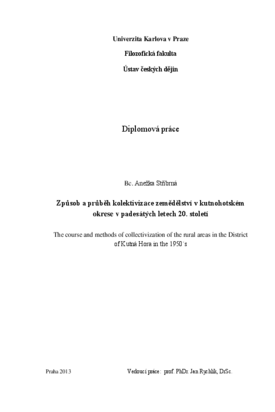Způsob a průběh kolektivizace zemědělství v Kutnohorském okrese v 50. letech 20. století
The course and methods of collectivisation of the rural areas in the District of Kutná Hora in the 1950's.
diplomová práce (OBHÁJENO)

Zobrazit/
Trvalý odkaz
http://hdl.handle.net/20.500.11956/54260Identifikátory
SIS: 122566
Katalog UK: 990016786980106986
Kolekce
- Kvalifikační práce [24991]
Autor
Vedoucí práce
Oponent práce
Michela, Miroslav
Fakulta / součást
Filozofická fakulta
Obor
Historie
Katedra / ústav / klinika
Ústav českých dějin
Datum obhajoby
27. 1. 2014
Nakladatel
Univerzita Karlova, Filozofická fakultaJazyk
Čeština
Známka
Výborně
Klíčová slova (česky)
okres Kutná Hora, kolektivizace zemědělství, socializace vesnice, jednotné zemědělské družstvo, kulakKlíčová slova (anglicky)
district of Kutná Hora, collectivization of rural areas, socialization of villages, collective farm, kulakDiplomová práce přibližuje průběh a způsob kolektivizace zemědělství v kutnohorském okrese v letech 1948-1960. Vychází z analýzy pěti obcí kutnohorského okresu - Bahno, Opatovice I, Petrovice I, Mitrov a Vranice (pro srovnání je zařazeno i městečko Kácov). Práce sleduje, jak se celostátně řízená zemědělská politika KSČ, její jednotné a závazné principy promítly do socializace konkrétních vesnic, jakým způsobem ovlivňovala jejich každodenní život a zasáhla do osudů jejich obyvatel. Dále se soustřeďuje na to, jak na ni reagovali jednotliví lidé, především místní funkcionáři, jaké volili prostředky a strategie jednání vůči vládnoucí moci. V centru pozornosti stojí otázka, zda a nakolik svými postoji mohli ovlivňovat a spoluvytvářet život v obci a jaký vliv měli na místní podobu socializace. Cílem práce je ukázat plastičtější obraz kolektivizace zemědělství a zároveň nabídnout jistou typologii postojů jejích aktérů. Kromě porovnání způsobu kolektivizace v konkrétních obcích umožňuje na jejich příkladu také ukázat rozdíly mezi první a druhou (závěrečnou) fází kolektivizace zemědělství. Práce čerpá především ze studia archivních materiálů a vzpomínek pamětníků.
The diploma thesis depicts the mode and course of collectivization of the rural areas in the district of Kutná Hora in years 1948-1960. It is based on the analysis of five villages - Bahno, Opatovice I, Petrovice I, Mitrov a Vranice (the little town of Kácov is also included for comparison reasons). The thesis describes how the unified binding principles of the state- controlled agricultural politics of KSČ reflected into the socialization of concrete villages and how they influenced the daily life and destinies of their inhabitants. The thesis also concentrates on the individual reactions towards the collectivization, especially those of local functionaries, focusing on which means and strategies these used against the ruling power. The central question is whether, and to what extent, the functionaries could influence and shape the village life and how they influenced the local form of socialization. The objective of this thesis is to show a more vivid picture of the agricultural collectivization and, at the same time, to offer a certain typology of its participants. Apart from the comparison of the mode of collectivization in concrete villages, their example also shows the differences between the first and second (final) phase of the collectivization of the rural areas. The thesis is based...
